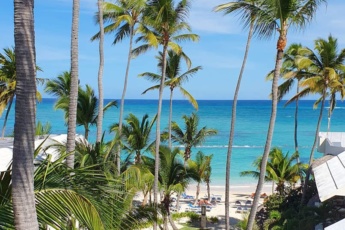Emergency Preparedness in 2025: What to Do if Disaster Strikes in Punta Cana
Understanding the Risks: Natural Disasters in Punta Cana

Emergency Preparedness in 2025: What to Do if Disaster Strikes in Punta Cana
Punta Cana, renowned for its breathtaking beaches and vibrant culture, is not immune to the harsh realities of natural disasters. To safeguard this tropical paradise, understanding the potential risks is essential for residents and visitors alike. Let’s delve into the types of natural disasters that could impact Punta Cana and their potential consequences.
1. Hurricane Activity and Trends
Punta Cana, located in the Caribbean, is particularly vulnerable to hurricanes, which can bring devastating winds, heavy rainfall, and storm surges. The hurricane season typically extends from June to November, with peak activity often observed from August to October. In recent years, climate change has contributed to an increase in the frequency and intensity of hurricanes, making preparedness more crucial than ever.
Hurricanes in the Atlantic Basin have become more unpredictable, with some reaching unprecedented wind speeds and rainfall levels. For example, Hurricane Maria in 2017, which severely impacted nearby Puerto Rico, serves as a stark reminder of the potential devastation. The Dominican Republic, including Punta Cana, must remain vigilant and ready to respond to these powerful storms.
2. Flooding Risks in Coastal Areas

Punta Cana
Coastal flooding is a significant concern for Punta Cana due to its low-lying geography and proximity to the sea. Storm surges caused by hurricanes can lead to severe flooding, damaging infrastructure, homes, and ecosystems. Additionally, rising sea levels, a consequence of global warming, exacerbate the risk of coastal flooding, making it more frequent and severe.
The region’s rainy season, from May to October, often results in heavy rainfall, which can overwhelm drainage systems and lead to flash floods. The impacts of these floods are far-reaching, affecting tourism, local economies, and the well-being of residents. It’s crucial to implement effective flood management strategies and infrastructure improvements to mitigate these risks.
3. Earthquake Vulnerability
While hurricanes and flooding are more common in Punta Cana, the area is not immune to the risk of earthquakes. The Dominican Republic sits on the boundary between the North American and Caribbean tectonic plates, making it susceptible to seismic activity. Although major earthquakes are relatively rare, even moderate tremors can cause significant damage due to the region’s infrastructure vulnerabilities.
Understanding the likelihood and potential effects of earthquakes is vital for ensuring safety and resilience. Building codes must be enforced and enhanced to withstand seismic events, and public awareness campaigns should educate residents and tourists about earthquake preparedness.
Comparison of Natural Disaster Risks in Punta Cana
| Disaster Type | Frequency | Severity | Seasonality | Primary Impact |
|---|---|---|---|---|
| Hurricanes | High | Severe | June – November | Wind damage, flooding |
| Coastal Flooding | Moderate | Moderate to Severe | May – October | Infrastructure damage, erosion |
| Earthquakes | Low | Moderate to Severe | Year-round | Structural damage |
By gaining a comprehensive understanding of these natural disaster risks, Punta Cana can better prepare and protect its residents and visitors. Acknowledging these threats is the first step in developing effective strategies to enhance resilience and ensure safety in the face of nature’s unpredictability.
Building a Comprehensive Emergency Plan
In the face of potential natural disasters in Punta Cana, having a well-structured emergency plan is not just advisable—it’s essential. Preparing a comprehensive strategy tailored to the unique challenges of this vibrant region can dramatically increase your safety and peace of mind in times of crisis.

Punta Cana
1. Creating a Family Communication Plan
Establishing a robust family communication plan is a critical first step in ensuring safety during a disaster. In Punta Cana, where natural disasters like hurricanes can disrupt communication networks, having a predefined plan can help maintain contact and provide reassurance.
- Designate a primary contact outside the affected area. This person can serve as a liaison for family members to relay information and confirm safety.
- Create a contact list that includes phone numbers, emails, and social media handles of all family members, as well as emergency contacts.
- Establish meeting points both inside and outside Punta Cana where family members can gather if separated. These should be easy to reach and well-known locations.
Additionally, consider incorporating technology into your communication plan. Mobile apps such as WhatsApp and Facebook Messenger can be invaluable for sending messages when traditional phone lines are down.
2. Essential Supplies for Your Emergency Kit
A well-stocked emergency kit can be a lifesaver in the event of a disaster. Given the climate and potential isolation due to blocked routes in Punta Cana, it’s important to tailor your kit to local conditions.
- Water: At least one gallon per person per day for at least three days for drinking and sanitation.
- Non-perishable food: A three-day supply of food that doesn’t require cooking or refrigeration.
- First aid kit: Include bandages, antiseptics, medications, and any necessary personal prescriptions.
- Flashlights and batteries: Reliable light sources are crucial during power outages.
- Portable phone chargers: Solar chargers can be particularly useful in Punta Cana’s sunny conditions.
- Local maps: In case GPS services are unavailable, maps of the local area can guide you to evacuation routes or safe zones.
3. Evacuation Procedures and Routes
Understanding evacuation procedures and routes in Punta Cana is a pivotal part of your emergency preparedness. Familiarizing yourself with this information ahead of time can dramatically improve response times and reduce panic during an actual event.
Identify the nearest evacuation routes from your residence or place of stay. These routes should be confirmed with local authorities to ensure they are current and accessible. It’s also wise to have multiple routes in case of roadblocks or damages.
Evacuation Routes Overview
| Starting Point | Main Route | Alternate Route | Destination |
|---|---|---|---|
| Playa Bavaro | Highway 3 | Local Road 2 | Higuey |
| Cap Cana | Highway 104 | Coastal Route | Santo Domingo |
| Downtown Punta Cana | Highway 105 | Scenic Route 1 | La Romana |
Incorporating these measures into your emergency preparedness plan can significantly enhance your resilience against the unpredictable forces of nature in Punta Cana. By being proactive, you not only ensure the safety of yourself and your family but also contribute to a more resilient community.
Leveraging Technology for Emergency Preparedness
In the modern era, technology plays an indispensable role in enhancing emergency preparedness. As Punta Cana continues to grow as a vibrant tourist destination, the integration of advanced technological tools becomes increasingly vital to ensure the safety and security of both residents and visitors.

Aerial view of Punta Cana
1. Emergency Alerts and Apps
Emergency alerts and applications have revolutionized how we receive critical information during disasters. These tools are essential in Punta Cana, where natural disasters such as hurricanes and floods can occur with little warning. There are several reliable apps and alerts systems designed to provide real-time updates, ensuring that residents and tourists are well-informed.
One of the most effective alert systems is the Integrated Public Alert and Warning System (IPAWS), which disseminates emergency messages across a range of platforms. Additionally, apps like the FEMA App offer features such as customizable alerts, emergency safety tips, and information on shelter locations.
Residents and tourists in Punta Cana are encouraged to download the Dominican Republic’s 911 App, which provides localized emergency information and direct access to emergency services. Utilizing these technological tools can significantly enhance personal safety and situational awareness during a crisis.
2. Using Social Media for Real-Time Updates
Social media has become a powerful tool for disseminating information quickly and effectively. During emergencies, platforms such as Twitter and Facebook can offer real-time updates, allowing users to stay informed and share crucial information with a vast audience.
In Punta Cana, local authorities and emergency services often use social media to broadcast updates on weather conditions, road closures, and emergency measures. By following official accounts, individuals can receive verified information and avoid misinformation that can spread during a crisis.
Moreover, social media enables community members to connect, share resources, and support each other. Hashtags such as #PuntaCanaSafety or #PuntaCanaUpdates can be used to streamline communication and ensure that important messages reach as many people as possible.
3. Satellite and Drone Technology for Monitoring
Satellite and drone technology have emerged as critical components in disaster preparedness and response. These advanced tools offer unparalleled capabilities in monitoring and assessing situations as they unfold, providing crucial data that can inform emergency management decisions.
Satellites offer a bird’s-eye view of weather patterns, helping to predict hurricanes and storms with greater accuracy. This data is invaluable for emergency services in Punta Cana, allowing for proactive measures to be taken before a disaster strikes.
Drones, on the other hand, provide flexibility and precision in disaster-stricken areas. They can be deployed to conduct aerial surveys, assess damage, and deliver supplies to inaccessible regions. In Punta Cana, drones are increasingly utilized to monitor coastal areas for flooding risks and to ensure that evacuation routes remain clear.
Our Apartments for Rent in Punta Cana
When preparing for potential emergencies, having a safe and secure place to stay is paramount. Explore our selection of well-equipped apartments in Punta Cana, designed to provide comfort and security even during unforeseen events.

Brand New 2BR Stylish Apartment in the Heart of Bavaro, Punta Cana - Gardenia Gated Community
from $128 night Read more
Brand New Apartment in Eden Tropical, Punta Cana, Bávaro - Prime Location, Rooftop Lounge with BBQ, Huge Pool
from $98 night Read more
New Tropical-Style Studio for Rent in Downtown Punta Cana - Pool-View, Gym, Parking, Short Drive to the Beach
from $99 night Read more
Modern Studio for Rent in Downtown Punta Cana, Las Mercedes - With Pool & Private Balcony - Self Check-in
from $90 night Read moreCommunity and Government Resources
In times of disaster, knowing where to turn for immediate help can be a lifesaver. Punta Cana is equipped with a range of community and government resources designed to help residents and tourists navigate the challenges of natural calamities efficiently and effectively.

Punta Cana
1. Local Emergency Services and Contacts
In any emergency, quick access to local emergency services is crucial. Punta Cana’s infrastructure includes several key services:
- Fire Departments: Equipped to handle fire-related incidents and provide rescue operations, these departments are strategically located and accessible.
- Police Services: Ensure public safety and order, with rapid response teams ready for deployment during disasters.
- Medical Facilities: Hospitals and clinics such as Hospiten Bavaro provide critical medical services. However, it’s essential to verify the accuracy and availability of these services prior to visiting.
- Emergency Hotlines: The national emergency number for the Dominican Republic is 911, which connects callers to fire, police, and medical services.
The provided information aims to offer guidance during emergencies; however, it is advisable to confirm details with official sources to ensure accuracy and timeliness.
2. Community Support Networks
In Punta Cana, community support networks play an essential role in disaster preparedness and recovery. These networks are formed through local community groups, neighborhood associations, and social organizations. Here’s how they contribute:
- Resource Sharing: Communities often pool resources such as food, water, and shelter to aid those in need.
- Volunteer Initiatives: Local volunteers organize efforts to assist with evacuation, provide first aid, and support cleanup operations post-disaster.
- Information Dissemination: Community leaders often act as liaisons between government entities and residents, ensuring timely and accurate information flow.
3. Governmental Policies and Assistance Programs
The government of the Dominican Republic has instituted various policies and programs to mitigate the impact of disasters and assist in recovery efforts:
- Disaster Relief Programs: These provide financial and logistical support to communities affected by disasters, ensuring rapid recovery and rebuilding.
- Educational Campaigns: Government-led initiatives educate the public about disaster preparedness, focusing on risk reduction and safety protocols.
- Infrastructure Development: Investments in resilient infrastructure aim to reduce vulnerability and enhance the ability to withstand natural disasters.
Government and Community Resources Analysis
| Resources | Role in Disaster | Contact Information |
|---|---|---|
| Fire Departments | Fire control and rescue operations | 911 (national emergency) |
| Police Services | Public safety and order | 911 (national emergency) |
| Hospitals | Medical aid and emergency care | Varies by location; verify locally |
| Community Networks | Resource sharing and volunteer support | Local community centers |
| Government Programs | Financial and recovery aid | Ministry of Public Administration |
Effective coordination between community networks and governmental bodies is vital for enhancing Punta Cana’s resilience against natural disasters. Residents are encouraged to engage with these resources actively to ensure preparedness and safety.
Sustainable Practices to Mitigate Disaster Impact
Embracing sustainable practices is not just an environmental choice; it’s a strategic approach to reducing disaster impact. In Punta Cana, where natural disasters pose significant threats, integrating sustainability into daily life can be a game-changer.

Punta Cana
1. Eco-Friendly Building Practices
In Punta Cana, adopting eco-friendly building practices has become an essential step towards disaster resilience. These practices not only reduce environmental impact but also strengthen the structural integrity of buildings against natural disasters.
Comparison of Traditional vs. Eco-Friendly Building Practices
| Aspect | Traditional Practices | Eco-Friendly Practices |
|---|---|---|
| Materials | Concrete and steel | Recycled materials, bamboo, and local resources |
| Energy Efficiency | High energy consumption | Energy-efficient designs, solar panels |
| Resilience | Basic structural integrity | Advanced disaster-resilient designs |
Eco-friendly construction involves using materials like bamboo, which is both sustainable and has a high strength-to-weight ratio, making it ideal for withstanding hurricanes. Similarly, integrating energy-efficient designs and utilizing solar panels can significantly reduce energy dependency, ensuring that essential services remain operational during outages.
2. Water and Energy Conservation
The conservation of water and energy is a pivotal strategy in mitigating disaster impacts. By implementing efficient resource management, communities in Punta Cana can enhance their resilience and ensure sustainability.
Water conservation techniques, such as rainwater harvesting, not only provide a supplementary water supply during shortages but also reduce the infrastructure strain during floods. Energy conservation, on the other hand, is fortified through the use of renewable sources like solar and wind energy. These practices not only cut down on costs but also ensure that power remains available during emergencies, reducing vulnerability.
3. Community Education and Involvement
Community education and involvement play a critical role in fostering a culture of preparedness and sustainability. By empowering residents with knowledge and practical skills, communities can collectively enhance their resilience to disasters.
Educational programs focused on sustainable living and disaster preparedness can significantly enhance community resilience. Workshops and training sessions provide valuable insights into sustainable practices, such as waste reduction and efficient resource usage.
Encouraging active community participation in these initiatives is crucial. Local organizations and government bodies can collaborate to create community networks that facilitate resource sharing and mutual support during crises. This approach not only reinforces solidarity but also ensures a coordinated response when disasters strike.
Our Sustainable Living Spaces in Punta Cana
Discover the perfect blend of luxury and sustainability with our eco-friendly living spaces in Punta Cana. Designed to withstand the elements while offering unparalleled comfort, these properties are the epitome of modern sustainable living.

Incredible Beach Condo Elite Suite D3
from $197 night Read more
Incredible Beach Condo Elite Suite C1
from $166 night Read more
Incredible Two Story Penthouse with Ocean View E4
from $277 night Read more
Punta Cana Condo for Rent - Secured Beachfront Rentals in Bavaro
from $177 night Read moreFrequently Asked Questions
What should I include in an emergency kit for a trip to Punta Cana?
When preparing an emergency kit for Punta Cana, include non-perishable food, bottled water, a first aid kit, a flashlight with extra batteries, a whistle, personal hygiene items, and any necessary medications. It’s also wise to have a copy of your travel documents, a portable phone charger, and a local map.
How can I stay informed about potential disasters in Punta Cana while traveling?
To stay informed, sign up for alerts from the U.S. Department of State’s Smart Traveler Enrollment Program (STEP), follow local news outlets, and download weather and emergency alert apps. Staying connected with your hotel staff for updates is also beneficial.
What are common natural disasters in Punta Cana and how should I prepare for them?
Punta Cana can experience hurricanes, tropical storms, and flooding. To prepare, familiarize yourself with your accommodation’s emergency procedures, have a plan for shelter, and keep your emergency kit ready. Always heed local warnings and evacuation orders.
Is it safe to travel to Punta Cana during hurricane season?
Traveling during hurricane season, which runs from June to November, can be safe with proper precautions. Monitor weather forecasts, have a flexible itinerary, and ensure travel insurance covers weather-related disruptions. Preparedness is key to safety.
What steps should I take if I need to evacuate due to a disaster in Punta Cana?
If evacuation is necessary, follow instructions from local authorities promptly. Have your emergency kit and documents ready, know your evacuation routes, and stay in contact with the U.S. embassy or consulate. Keep your family and friends informed of your whereabouts.
How can I ensure my travel insurance covers emergencies in Punta Cana?
Before traveling, review your travel insurance policy to confirm it covers natural disasters and medical emergencies. Contact your insurer to clarify any coverage doubts and consider additional coverage if necessary.
What role does the local government play in disaster preparedness in Punta Cana?
The local government in Punta Cana works to ensure public safety by issuing warnings, coordinating evacuations, and providing emergency services during disasters. Familiarizing yourself with their procedures can help you respond effectively in an emergency.
Are there specific accommodations in Punta Cana that are better equipped for emergencies?
When booking accommodations, look for properties that have a well-established emergency response plan, such as hurricane shelters or backup power supplies. Contact the hotel directly to inquire about their specific emergency measures.
What should I do if I experience a medical emergency during a disaster in Punta Cana?
In a medical emergency, contact local emergency services immediately. Have the contact information for the nearest hospital or clinic handy. Notify your hotel or local contacts for assistance. Consider having travel insurance with medical evacuation coverage.
Can I rely on local emergency services in Punta Cana during a disaster?
Local emergency services in Punta Cana are trained to handle disasters, but during widespread events, response times may vary. It’s crucial to follow all official instructions and have a personal emergency plan in place to enhance your safety.
Be aware that infrastructure may be strained during a disaster, and always have a backup plan.
